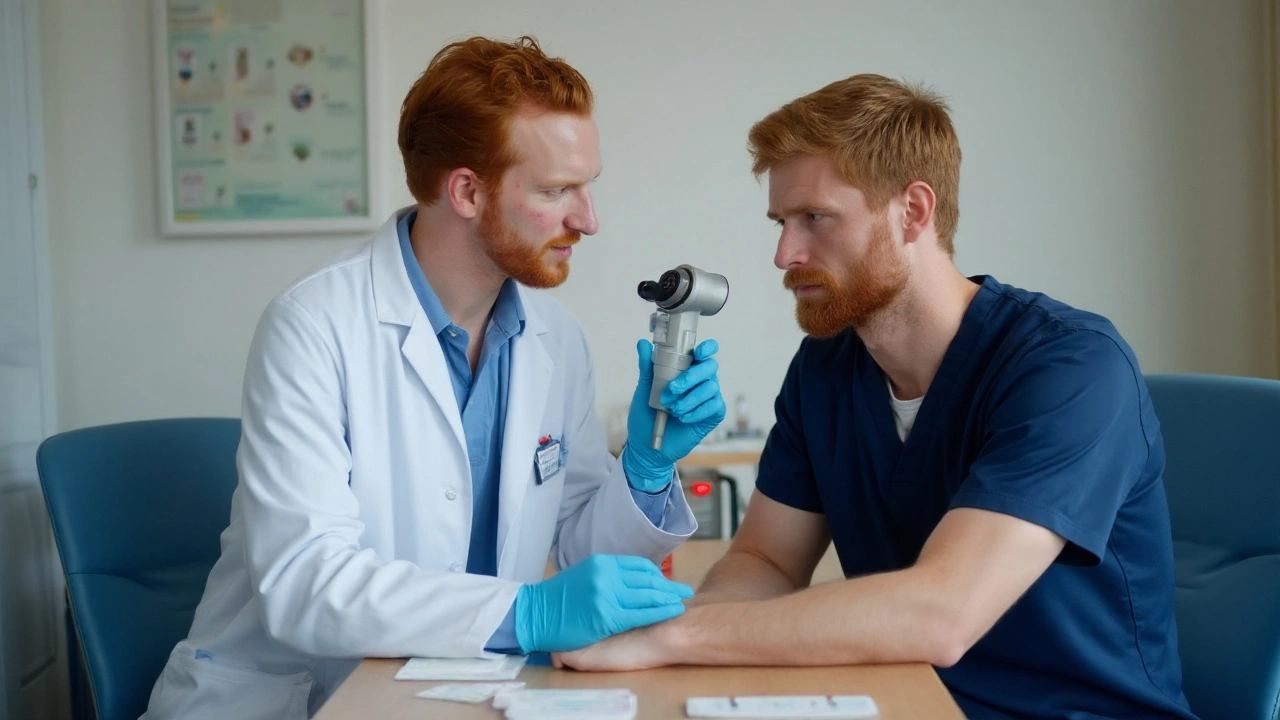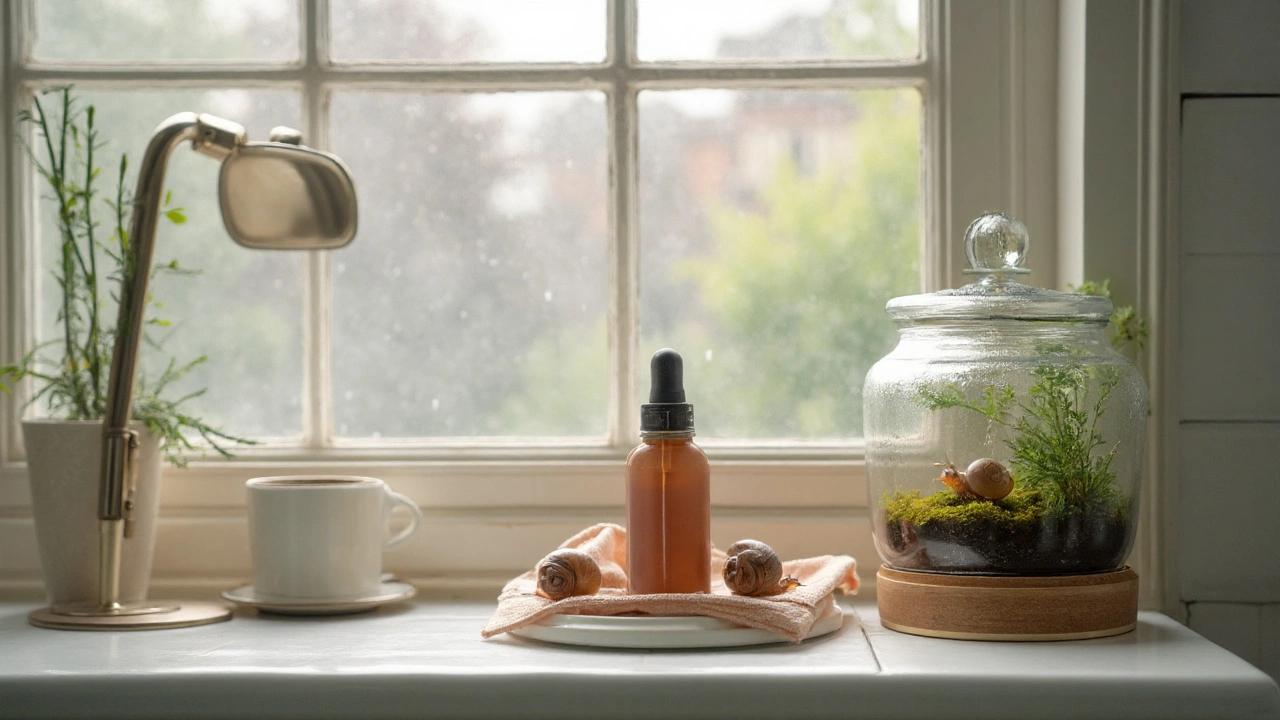Yes, people really put snail goo on their faces-and some even let snails crawl over their skin. The surprise is how normal this has become in pro facials and celebrity prep. The less wild reality: most of the world’s “snail facials” use a refined snail mucin serum plus gentle massage, not a terrarium on your cheeks. If you’re wondering what it does, how to try it without wrecking your skin barrier, and whether it’s worth the hype, you’re in the right spot.
- TL;DR: This trend pairs snail mucin (for hydration and repair) with light facial massage (for glow and de-puffing). It’s more about technique than actual snails.
- Good for: surface dehydration, dullness, mild textural unevenness; not a cure for deep wrinkles or severe acne.
- Science: small but real support for mucin’s wound-healing and barrier benefits; massage improves microcirculation short term.
- Safety: patch test 24-72 hours; avoid if you have mollusk allergies or active rashes. Keep pressure light and avoid picking.
- Results: instant glow; best seen after 4-8 weeks of consistent use, 2-4 times/week.
What Snail Facial Massage Actually Is (and Why Celebs Use It)
When people say “snail facial,” they usually mean one of two things:
- Snail mucin-assisted facial massage: a topical serum or gel made from snail secretion filtrate (usually from Cryptomphalus aspersa or Helix aspersa) used as the glide medium during a gentle massage. This is what most celebrity facialists use backstage or pre-red carpet.
- Live snail spa: sanitized snails glide over the face while a therapist directs their movement. It’s novel, but rare outside a handful of clinics. Most clients choose the serum route.
Why it’s hot with glam teams: mucin is a humectant that hugs water, adds slip without heavy oil, and leaves a glossy finish under makeup. The massage itself boosts fluid movement and softens tension so skin looks fresher on camera in under 20 minutes.
What’s inside snail mucin? Glycoproteins, hyaluronic acid, allantoin, antimicrobial peptides, trace glycolic acid, and antioxidants. Dermatology literature has followed a standardized snail secretion, often labeled SCA (Secretion of Cryptomphalus aspersa), showing improved healing post-procedure and modest photoaging benefits after several weeks in small human studies (Journal of Drugs in Dermatology, 2013-2015; Journal of Cosmetic Dermatology, 2018). Allantoin and HA are well-known for soothing and hydration, while peptides support repair signals.
What massage contributes: Light effleurage and lymph-friendly strokes temporarily increase local blood flow and help reduce puffiness. Instrument studies using laser Doppler flowmetry show short-term microcirculation improvements after facial massage, translating to that immediate “I slept eight hours” look. The effect is real but temporary; consistency matters.
Reality check on results: you’ll see instant glow and smoother makeup laydown from day one. Texture, fine-line softening, and barrier strength build over 4-8 weeks. Deep wrinkles, etched lines, and inflammatory acne won’t disappear with this alone.
If you take one thing away: a solid routine and gentle technique matter more than which snail you pick. The trend’s power is the combo-hydration + mindful touch-not a miracle ingredient on its own.
How to Do a Snail Facial Massage at Home (Step-by-Step)
If you’re going to try this, keep it simple, gentle, and clean. Here’s a routine that mirrors what pro facialists do, minus the spa robe.
-
Patch test first (24-72 hours)
Dab a pea-sized amount of the mucin product along your jawline or behind your ear. Wait at least a full day (ideally three). If you see redness, itching, or hives, skip this trend. -
Cleanse-no stripping
Use a mild, low-foam cleanser. Rinse with lukewarm water. Pat until skin is damp, not dry; humectants like mucin perform better on slightly wet skin. -
Optional: Mist or essence
A hydrating mist or essence lays down water for the mucin to grab. Avoid exfoliating toners here; they can irritate when combined with massage. -
Apply snail mucin
Spread a nickel-sized amount across face and neck. If it feels tacky, that’s normal. You want enough slip that fingers glide without dragging. -
Massage map (5-8 minutes total)
- Neck to jaw: light upward strokes from collarbone to jawline, both hands, 1 minute.
- Jaw release: knuckles sweep from chin to ear along the jaw, feather-light, 1 minute.
- Cheeks: palms or fingertips glide from nose out to temples, 1-2 minutes.
- Under eyes: ring fingers make tiny outward circles from inner corner to temple, barely any pressure, 30 seconds each side.
- Brow lift: thumbs under brows, gently press and release moving outward, 1 minute.
- Forehead: glide from center to hairline and temples, 1 minute.
Keep pressure at a “2 out of 10.” If skin blanches or you feel drag, add one more pump of serum.
-
Seal it in
Tap on a light moisturizer to lock the water in. Oily or acne-prone? Choose a gel-cream. Dry? Use a cream with ceramides. -
AM vs PM
AM: finish with SPF 30+. PM: if you use retinoids or exfoliating acids, don’t stack them right after this on the same night. Alternate nights to keep your barrier happy. -
Frequency
2-4 times per week is a sweet spot. Too much rubbing can irritate-more isn’t better.
Tool tips: Hands are best. Gua sha or rollers can work, but mucin can be tacky-use a few drops of squalane or a light face oil mixed with the mucin if a tool snags. Clean tools with soap and water before and after.
Breakout-prone? Keep strokes light, avoid massaging over inflamed pustules, and disinfect your hands. If you’re mid-flare, skip massage and just pat on products.

Benefits, Risks, and What the Science Actually Supports
Let’s separate the glossy marketing from what’s likely.
- Hydration and barrier support: The strongest, most consistent benefit. Humectants in mucin pull water into the upper skin layers. Allantoin soothes. People feel bouncier skin within days.
- Texture and fine lines: Modest improvements after 4-8 weeks, especially when skin is dehydrated to start. Controlled studies on SCA show small but measurable changes in photodamage scores over 8-12 weeks.
- Post-procedure recovery: Dermatology clinics have used snail secretion-based products to support healing after lasers and peels. Human studies report faster re-epithelialization and less redness compared with bland moisturizers in small cohorts.
- Antimicrobial/anti-inflammatory signals: Lab data suggests mucin molecules and peptides may discourage some microbes and calm irritation, but don’t expect it to treat moderate-to-severe acne on its own.
- Massage effects: Increases short-term blood flow and reduces perceived puffiness and muscle tension. It’s a finish, not a fix.
Risks and when to skip it:
- Allergy and irritation: Rare but real. People allergic to mollusks (snails, slugs) have reported reactions to snail-derived cosmetics. Cross-reactivity with dust mite or shrimp allergies can occur. Patch test.
- Active acne and rosacea flares: Friction can stoke inflammation. Keep contact ultra-light or wait until flares calm down.
- Sensitivity stacking: Pairing long massages with retinoids, AHAs/BHAs, or scrubs can tip skin into irritation. Alternate nights or shorten massage to 2-3 minutes.
- Live snail facials: Hygiene matters. Without strict sanitation, there’s a theoretical risk of bacterial transfer. Ask the clinic about their protocols and veterinary oversight.
- Ethical and dietary concerns: Mucin is animal-derived. Some brands claim cruelty-free extraction (no harm to snails), but this varies. Vegans may prefer algae or polyglutamic acid as an alternative humectant.
Safety guardrails dermatologists commonly advise: patch test new actives for 24-72 hours; avoid introducing multiple new products at once; pause actives if you notice stinging that lasts beyond a minute; and use SPF daily, especially when you’re improving the barrier and then layering other actives on alternating days.
What to Buy, What It Costs, and How It Compares to Spa Options
You don’t need an expensive product to try this trend. What matters: a reputable mucin percentage, clean preservation system, and textures that glide without tugging.
Buying checklist (quick):
- Mucin type: look for “snail secretion filtrate” high on the ingredient list.
- Texture: serum or gel that doesn’t pill under moisturizer or SPF.
- Allies: added hyaluronic acid, panthenol, and allantoin are helpful; avoid heavy fragrance if you’re sensitive.
- Packaging: pump or squeeze tube beats open jars for hygiene.
- Brand transparency: statements about sourcing and allergen testing are a plus.
Price reality (2025): drugstore mucin serums run $12-$25; mid-range K-beauty, $20-$40; dermatologist-dispensed SCA products, $70-$140. A pro “snail facial” with massage costs anywhere from $90 to $250 depending on city and add-ons.
| Aspect | At-Home Snail Facial Massage | Spa/Clinic Snail Facial |
|---|---|---|
| Typical cost (US, 2025) | $12-$40 for serum; pennies per session | $90-$250 per session |
| Time | 8-12 minutes total | 45-75 minutes |
| Products used | Snail mucin serum/gel, moisturizer, SPF | Pro formulations, steam, extractions, devices |
| Hygiene control | Up to you-wash hands/tools | Licensed protocols; ask about sanitation |
| Results | Instant glow; builds with consistency | Immediate glow; often longer-lasting finish |
| Best for | Maintenance, budget-friendly upkeep | Events, deep relaxation, add-on treatments |
| Risk level | Low with patch testing and gentle pressure | Low-moderate; depends on devices/extractions |
| Who should skip | Mollusk allergy, active dermatitis/eczema flare | Same; plus ask about live snails and sanitation |
Pairing rules of thumb:
- With retinoids: alternate nights or do massage first, then a bland moisturizer; save retinoid for the next evening.
- With vitamin C (AM): fine-massage gently, let mucin dry, then vitamin C, moisturizer, SPF.
- With acids (AHA/BHA): don’t stack with long massage sessions; space by 24 hours.
- With acne meds (benzoyl peroxide): apply treatment first, let it dry, then a short 2-3 minute mucin massage to reduce dryness at the edges.

Cheat Sheets, FAQs, and What to Do Next
Quick-start checklist:
- Patch test 24-72 hours.
- Work on damp skin.
- Light pressure only; stop if you see redness that lingers.
- 5-8 minutes, 2-4x per week.
- Seal with moisturizer; SPF in the morning.
- Don’t stack with strong actives on the same night.
- Clean hands and tools before/after.
Red flag checklist (pause and reassess):
- Itching, hives, or swelling after application.
- Burning that lasts more than a minute.
- Worsening acne or new clusters of pustules.
- Eye irritation-keep products a finger-width from lower lash line.
Mini-FAQ
- Is it vegan? No. Snail mucin is animal-derived. Plant-based alternatives that mimic the feel: polyglutamic acid, aloe, tremella (snow mushroom), and panthenol.
- Is it cruelty-free? Some brands say they collect mucin without harming snails via gentle stimulation. Standards vary. Ask brands for details if ethics drive your choices.
- Safe in pregnancy? Mucin itself is generally considered low risk topically. The bigger question is what else is in the formula. When in doubt, check with your clinician and skip live-snail services.
- Will it clog pores? Mucin is light and usually non-comedogenic. Breakouts tend to come from heavy occlusives layered on top. Choose gel-cream textures if you’re acne-prone.
- Can I use it with retinol? Yes-alternate nights or layer mucin earlier in the evening and retinol on a different night to avoid irritation stacking.
- Does it fix acne scars? It may soften surface texture a little with time, but atrophic scars need in-office treatments (microneedling, lasers, peels) supervised by a dermatologist.
- Live snails-sanitary? Only in clinics with clear protocols. Ask about snail sourcing, cleaning solutions, and veterinary oversight. If you’re immunocompromised, skip live-snail services.
Scenarios and next steps
- Sensitive skin newbie: Start twice a week, 3-4 minute massage tops, fragrance-free mucin, and a ceramide moisturizer. If your skin stays calm after two weeks, add a third session.
- Acne-prone and oily: Keep hands clean, skip massaging over inflamed spots, and use a gel moisturizer to finish. Consider pairing on alternate mornings with a gentle BHA at night.
- Dry and flaky: Mist, mucin, 8-minute massage, then a ceramide cream and a few drops of squalane to seal. Do it at night and let it work while you sleep.
- Mature skin (fine lines): Add peptides or niacinamide in the same routine, but keep massage light to preserve capillaries. Track progress with before/after photos every 4 weeks.
- Event prep (tonight): Do a 5-minute session, pat in moisturizer, wait 10 minutes, apply a gripping but hydrating primer, then makeup. You’ll get that fresh, juicy base.
- Vegan path: Swap mucin for tremella or polyglutamic acid. The massage sequence stays the same.
Troubleshooting
- Pilling under makeup: You’re layering too fast or using competing polymers. Let each layer set 60-90 seconds, use less product, and choose a simpler primer.
- Sticky finish: That’s normal for 5-10 minutes. If it bothers you, mix one drop of squalane with your mucin or finish with a lightweight moisturizer to reduce tack.
- Redness after massage: Your pressure is too high. Use more slip, slow down, and cut time to 3 minutes until your skin adjusts.
- No results after a month: Increase consistency to 3-4x per week, photograph progress in similar lighting, and make sure you’re applying on damp skin. If still nothing, it may not be your ingredient-try a different hydrating backbone.
- Breakouts near hairline/cheeks: Clean tools, wash pillowcases more often, and avoid pushing product into hairline where occlusive styling products live.
One last clarity note: a snail facial massage works best as a hydrating, barrier-friendly add-on inside a balanced routine. Think of it as your skin’s water bottle and a quick tension reset, not a substitute for sunscreen, retinoids, or targeted acne care. Used right, it earns its place.
